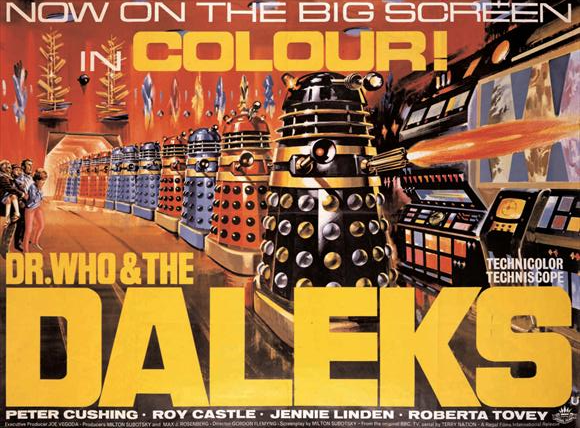Doctor Who was written by Terry Nation (1930 – 1997), amongst others, who before his inauguration into the Doctor Who franchise, and personally creating the Dalek, was already writing for television, with works as The Saint with Roger Moore and The Avengers during the 1960’s. The year 1963 was to be the year that an unsuspecting British television audience would be captured and mesmerised, and for the next forty years too, by an old mysterious being from another world, another time; Dr. Who had arrived.
Doctor Who: The Dead Planet, a seven-episode show for television, which first aired in 1963, was his first adventure into this concept, that was played by the original Doctor: William Hartnell (1908 – 1975). Terry Nation continued to be one of the main innovators’ toward the Doctor Who legend, with writing creditability’s from 1963 to 1979. His work also includes the British sci-fi Blakes 7 and The Persuaders! With Roger Moore and Tony Curtis.
Dr. Who and the Daleks is based around the 1963 episodes The Dead Planet, with a movie feel towards it and by 1960’s standards a huge budget of £180,000. This was a big production; the first of it’s kind for this franchise and shot in Technicolor and Technoscope, a 35mm film technique that laid each frame horizontally end-to-end instead of vertically. With the international movie star Peter Cushing O.B.E. to headline, not as a time travelling alien, the last of his breed, but an eccentric, inquisitive and inventive scientific Grandfather, known as Dr.Who, not as The Doctor as he is referred to in the television series.
Dr. Who and the Daleks was the first taste of the Doctor Who name for the American market, released there during July 1966, though not too successful in the US’, as here in England. This well-known television show spin off needed very little prompting, just the mass hysteria and movie publicity throughout the nation would most certainly keep these wheels of industry well oiled. Star Wars some twelve years later would be the next huge movie franchise, but on a global stage, rather than on an English lawn as Dr. Who and the Daleks were. Successful it was indeed, with massive merchandising rights too, toys, books etc, this was the big time for the small screen; Dalekmania had landed.
Dr. Who’s invention of the time travelling machine T.A.R.D.I.S. (fully known as Time And Relative Dimension In Space), that he with his two young granddaughters and young male friend, played by Roy Castle (1932
1994) as Ian, set of to another world and time with, land on planet
Skaro. Here they encounter the passive life forms of the Thals, and their struggle against the repressive and destructively evil Daleks, these living creatures that can only live inside their metal casings to survive, their aim, is for interplanetary domination, taking no prisoners along the way, to destroy, to exterminate everything that crosses their path.
Dr. Who and the Daleks can share, coincidently, similar parallels to the 1960 movie The Time Machine, with Rod Taylor as George Wells, such as the time traveller and his plight against the evil Morlocks fighting the also passive Eloi people and their uprising for survival.
Dr. Who and the Daleks, remember this is 1965, is a wonderful concoction of colour and imagination, with an impressive budget to play with, there was little wasted in creativity and design, with the full use of the Shepperton Studios to their advantage, no expense was spared, the sets are stunning and the Thal costumes look very chic. This also is the first outing for the Daleks to be seen in full colour, and the differing colours of the Daleks, to signify their ranks, would, and still do, thrill and captivate their audience, particularly the children who were hiding behind their cushions while watching.
Dr. Who here is a sixties nostalgia trip, with its now retro styled look and feel, feeling dated but never out dated. This is nineteen sixties science fiction at its visual best, it really is, along with its international star, the Doctor Who brand name had transcended to a higher level of escapism. Though differing from the television series, this doppelgänger, the parallel world that is Peter Cushing’s Dr.Who is at times a little flat, while we are hypnotised by the colourful Daleks and their surrounds, we are sometimes left behind in a script whose pace can reel us back not forward. Peter Cushing’s Doctor is a lovable old sea dog type, of the time traveller variety, very nice to know and not at all grumpy, spiteful and rude; placid and charming is his nature here, it’s the adventures that he stumbles across that make him interesting.
Dr. Who and the Daleks is basically relying on the success of the television series to help cash in, then watched by millions of children each week. With its target audience already in great supply and ever hungry, as children always are, to help itself to its own fame and fortune, this helps, only for a while, until we are left with a parody, a pastiche of the real thing. Not an out and out copy, just a good movie with an interesting idea that could blossom into a beautiful friendship between makers and fans alike, I feel another movie in the air, time will tell.

